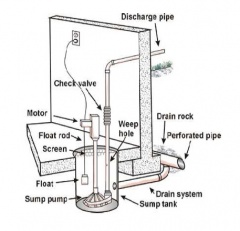What you Need to Know About Sump Pumps
A sump pump is a submersible pump used to remove standing water from the ground. Often mounted in a plastic basin dug into the ground, they help by relieving water pressure from the surrounding soil. You’ll find them in both concrete slab installations, such as in a basement, or in crawlspaces, set into the soil. They do not run continuously, but rather activate when the water level reaches a certain point.

What happens when a sump pump fails?
Flooding, wood rot, mold damage; a host of scary issues can arise when a sump pump fails to adequately remove ground water. Ideally, a sump pump has a backup pump or, at a minimum, an alarm. If not, the problem often goes unnoticed until significant damage has already occurred.
The damage occurring from a sump pump failure depends entirely on the location of the sump pump. If the pump is installed in the crawl space, the damage is often minimal. Likely the vapor barrier will require replacement, but framing is fairly resilient. If the pump is installed in a basement and a failure occurs, the damage can quickly become expensive. Basement mold can attack framing, sheetrock, carpeting and a host of other materials.
Picking a sump pump.
- Manual vs. Automatic. In nearly all circumstances, an automatic sump pump is superior. The additional cost is minimal and the peace of mind is invaluable. Manual sump pumps are typically only used for catastrophic events such as river flooding. Of course, just because a sump pump is “automatic” doesn’t mean it will always work. The water sensing mechanism can easily malfunction due to clogging and render the unit useless.
- Single vs. Primary W/ Backup. Recently, many homeowners have began installing sump pumps with a secondary backup unit. These two stage units were designed to address the fairly common occurrence of a mechanical failure. Unlike other household appliances, if a sump pump fails, it will usually lead to an extremely expensive flooding event. Thus, spending an extra couple hundred bucks on a backup unit is cheap insurance.
- Normal vs. Battery Backup. What happens when the same storm that threatens to flood your basement also knocked out power to your home? Unless a battery backup is in place, the sump pump will fail. This is a fairly rare event of course, and many home owners elect to forego the extra protection. Base your decision on the likelihood of power outages. In the Pacific Northwest, where trees straddle every power line, power failures are common. However, in many locations, these are rare enough events to skip the battery backup.
- Sewer vs. Storm Drain. In the past, sump pumps were just piped into the existing sewer line running out from the house. This worked well until the local water treatment plants ran out of capacity. In response, many municipalities created laws banning sump pumps from directing water into sewer lines. Why does this matter? Often, it is much more difficult to tie into a storm drain that a sewer line.
I have a sump pump in my basement, is this a problem?
- Many people believe that a sump pump is an accident waiting to happen. However, if the system is properly installed and maintained, they can operate very reliably. The truly catastrophic issues occur when the pump fails for a substantial period of time before someone notices. For this reason, every sump pump must have both a backup pump and a water alarm.
How involved is a sump pump installation?
- Installing a sump pump can be a significant investment. If you’re merely replacing an existing system, the cost could be as low as $500-$1,000. However, if your installing a new system, plan on spending more. The largest variables in the price are the distances to plumbing and trenching/concrete work.
When is a mold remediation professional necessary for a sump pump issue?
- When a sump pump fails, mold growth often occurs as well. If this is the case, a certified mold professional is recommended. The necessity of a mold expert depends largely on the location of the sump pump. If it is located in a finished basement, and carpeting, drywall and contents are saturated, a mold professional is critical. If the sump pump is located in the crawlspace and the excess water simply pooled on the soil, an expert may not be called for.
*Heads up – I earn a small commission on sales through Amazon links. This helps cover the expense of running the website (and answering your questions!)
Got a question? Ask it here and we'll post the answer below
I have two sumps located in diagonal corners of my basement as part of an interior pressure relief system. Each sump services the two adjacent trenches with gravel, 4" ABS perf pipe, weep holes in the lower course cinder block, etc. Question is, should the sump pump tank have small holes in the bottom to allow water collecting under the pad to rise into the tank and be pumped out away from the foundation? Of the two sumps one appears to have holes in the bottom of the tank and one does not. It seems like a good idea to have the holes as just another way to relieve ground water pressure.
Sump pump basins typically do not have holes on the bottom. This helps prevent the entrance of mud/debris that can begin filling up the basin and clog the pump. However, a correctly installed sump pump will have a bed of drain rock beneath the basin, which will also prevent the entrance of mud.
